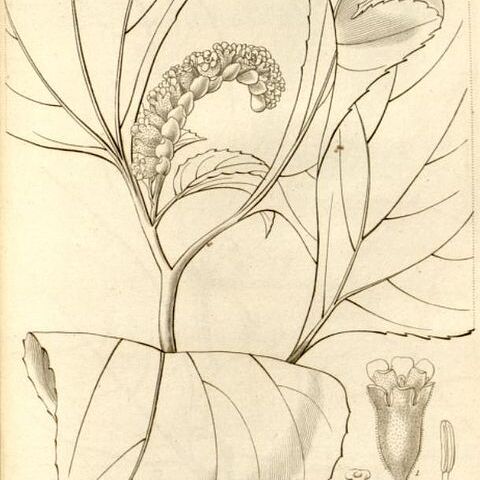Perennial ± succulent herbs, often somewhat woody and procumbent and rooting at the base, often clothed with branched multicellular hairs; habit sometimes recalling certain Gesneriaceae (Cyrtandra, etc.). Leaves alternate, simple, mostly ± asymmetrical, sinuate-denticulate or subentire, ± fleshy, petiolate, exstipulate. Inflorescences axillary, cymose, often scorpioid, acropetal, solitary or 2-3 together in each axil. Bracts usually rather large and membranous. Flowers hermaphrodite (rarely unisexual), actinomorphic (calyx excepted), shortly pedicelled or sessile. Calyx-tubs campanulate or linear-cylindric, adnate to the ovary by means of 5 longitudinal septa formed by the continuation of the filaments, leaving 5 deep nectariferous pits below the petals; lobes 5, imbricate, mostly membranous, persistent, unequal (2 larger and 3 smaller), coloured (mostly whitish). Corolla inserted at the apex of the calyx-tube, variously gamopetalous or less frequently choripetalous, ± campanulate, mostly fleshy or cartilagineous, occasionally delicate in texture, persistent, segments or petals 5 (rarely 4), valvate (sometimes induplicate), often reflexed at the apex. Stamens 5, alternipetalous, shortly adnate to the corolla (when gamopetalous); filaments persistent; anthers ovate, oblong or linear, introrse, basifixed, dehiscing by slits. Ovary inferior, 2-locular; placentas axile, bifid, multi-ovulate; style short, thick, simple; stigma massive, oblong-cylindric, often strongly 5-ribbed. Ovules very minute, very numerous, pendulous, anatropous, with 1 integument. Fruit baccate, indehiscent. Seeds minute, ovoid; testa reticulate, brown; embryo minute; albumen copious.
Morphological characters and geographic distribution are the same as those of the family.

